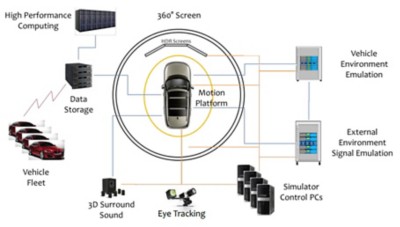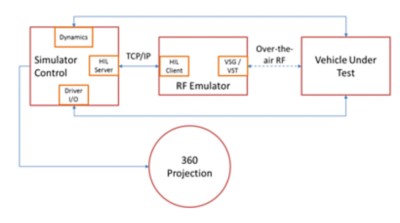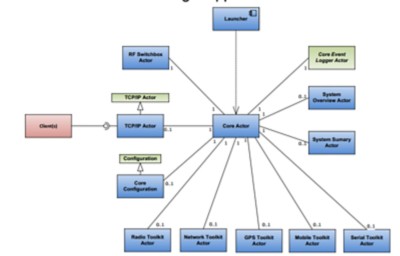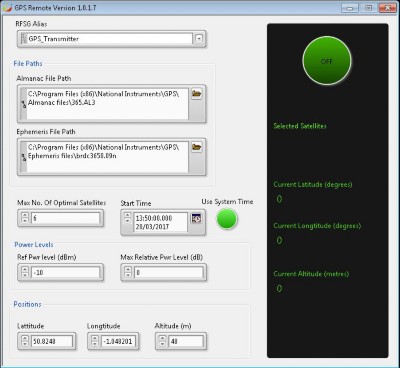Accurate Emulation of Satellite Signals for a Full-Scale Vehicle Simulator Enables Driving Anywhere Around the Globe
Gunwant Dhadyalla, WMG, University of Warwick, Principal Engineer
"We at WMG have already performed closed-loop GNSS position transmission by combining the environment simulator and RF emulator into one system. By doing this, we were able to vary signal strength and satellite visibility based on scenery in an HIL environment."
- Gunwant Dhadyalla, WMG, University of Warwick, Principal Engineer
The Challenge:
The Warwick Manufacturing Group (WMG) needed to develop a connected vehicle simulator environment to test and characterize any new technology (infrastructure, communications, and on-vehicle systems) in real-world conditions with a driver in the loop. This would allow vehicle OEMs to test earlier in the design cycle using a repeatable and controlled environment.
The Solution:
WMG researchers used NI hardware and software with scenario-generation tools to emulate satellite constellations and other RF signals and control their signal quality according to the driving environment.
Intro
WMG at the University of Warwick houses a unique facility that provides a fully simulated environment for smart, autonomous, and connected vehicles. Around the globe, many automotive companies and research institutes have developed or are developing simulators to research, test, or validate new technology, Advanced Driver Assistance Systems (ADAS), vehicle dynamics, control algorithms, or user experiences. To help bring together industry and academia, we at WMG are hosting the National Automotive Innovation Centre (NAIC) to accelerate novel, collaborative R&D in the automotive sector such as the work under way in connected and autonomous vehicle (CAV) virtual verification and validation.
As we aim to grow confidence in CAVs, we know we cannot achieve this with physical road tests alone. WMG’s 3xD Simulator for Intelligent Vehicles aims to provide an innovative platform to bridge the gap between traditional hardware-in-the-loop (HIL) and road-based field tests. The simulator provides a drive-in, driver-in-the-loop, and multiaxis driving experience, hence the “3xD” in its name.
The simulator provides a real-time, safe, controlled, and repeatable physical environment, which allows for not only the sensor and communications to be in the loop but the driver as well!
The WMG 3xD simulator is housed in an RF-shielded room (Faraday cage) that can accommodate a full vehicle. Through this complete isolation, external RF signals are blocked, and the complete RF environment can be emulated along with the visual environment for the driver and other sensory systems to the vehicle electronic systems.
Ability to Test Earlier in the Product Development
Several other simulators are available, so we wanted to provide a first-of-its-kind facility that can be used to test, verify, and validate new technology and full systems in a connected and immersive way. Our aim is to not only generate the scene around the vehicle (stimulate sensors) but also integrate it with the RF environment, including satellite information. This would enable a driver to be completely immersed and in the loop and enable the vehicle manufacturer to test its vehicle earlier in the design process to avoid costly design changes that may be required if defects are found later. The simulator would provide insight into how both the user and system (vehicle) interact with their environment within a safe, controlled, and repeatable environment. For example, we can test how the driver reacts when we add noise to the car stereo or how the vehicle reacts when satellite signals are lost in an urban environment.
Communication Capabilities
We wanted to fully emulate the vehicle’s and driver’s sensors, which includes not only LiDAR, RADAR, and scenery generation (visual) but also Bluetooth, 4G, V2X, and, most importantly, location information using GNSS.
Emulating satellite constellations that provide position information (GNSS) requires distinguishing between different environments. Driving on urban roads, intra-urban roads, and motorways inhibits different signal characteristics, such as signal strengths, reflections, and a number of satellites that are visible.
We selected NI’s PXI platform to emulate the RF environment because of the versatility and flexibility of the equipment. By combining it with LabVIEW, we can program the vector signal transceivers to dynamically change the signal type and strength of the satellites depending on the vehicle’s simulated position. Because of the flexibility of the platform, we also can generate 3G, 4G/LTE, Bluetooth, or digital radio. In the future, we will use the platform with NI USRP devices to generate V2X for testing vehicle-to-infrastructure (V2I) and vehicle-to-vehicle (V2V) HIL within a synthetic environment.
Simulator Architecture
The 3xD simulator includes a 360-degree projection screen, a real-time vehicle emulator to emulate engine and transmission, an in-vehicle surround sound system, extensive data storage, and the RF environment emulator (see Figure 3).
Figure 4 shows how the simulator control system connects to the vehicle environment emulator and the environment signal emulation system over a TCP/IP link.
The RF emulator uses three NI PXIe-1085 chassis with two vector signal generators (6.6 GHz) and two vector signal transceivers (6.6 GHz) that can generate GNSS, AM/FM/DAB, and 4G/LTE channels simultaneously.
The vehicle environment simulator includes a scenario editor, which is used to define road setups, object placements, road signage, and other traffic. During the simulation, this data along with information such as velocity, direction, acceleration, object size, and location is provided to the RF emulator. Additional information from other simulated traffic such as turn indicators and brake light status is provided for V2X connectivity testing.
We worked with an NI Partner to develop the software for the RF emulator using LabVIEW. We applied the object-oriented Actor Framework to help create multiple independent functions, which can communicate with each other in a single application. In addition to core functionality, examples of specific actors are infotainment radio, GNSS, and mobile and network actors. The NI Partner helped us speed up our development and provided at-hand programming expertise and a software architecture that can scale with our future needs.
For the vehicle environment generation, we can apply multiple tools such as XPI Simulation’s iOS. LabVIEW enabled us to create an actor that can communicate bidirectionally with the XPI Simulation iOS and extract the necessary information about the scene for the RF emulation.
Lost Satellites
A typical test generates the GNSS signals, depending on the simulated location and scene. The location data is converted into the actual satellite positions to construct a satellite constellation signal, which is transmitted to the vehicle navigation system. When the vehicle drives through an urban environment, the software automatically decreases the signal strength and the number of visible satellites. These adjustments can also be implemented manually through a user interface.
Another use case involves the validation of vehicle-to-vehicle (V2V) communication. One V2V unit on the real vehicle inside the simulator and one V2V unit externally provide information from a virtual car to our vehicle. The driving scene simulator generates a virtual car merging in front of our car and then performing a braking action. The location, velocity, and other information are sent over TCP/IP to the RF emulator. Besides the RF satellite signal for the one vehicle (transmitted over the air), the NI RF emulator generates a second satellite constellation signal that is fed into the second V2V control unit (using a cable). This unit locates its position and constructs a V2V message to be sent over the air to the real vehicle in the simulator room. The intelligent vehicle then can make decisions such as braking or initiating emergency avoidance maneuvers.
Value of Partnerships
The NI platform allows customization through LabVIEW. The NI sales team suggested we work with an NI Partner for the implementation, and this proved to be key to our success. Working with NI Partners was a real benefit because they have strong experience with the NI platform and tools, and they can provide reliable solutions.
We at WMG have already performed closed-loop GNSS position transmission by combining the environment simulator and RF emulator into one system. By doing this, we were able to vary signal strength and satellite visibility based on scenery in an HIL environment. We plan to emulate current and future constellations, for example, what drivers will see when they drive in Tokyo in 2025.
The NI equipment provides a flexible platform for our connectivity research and enables us to further research topics like channel emulation and channel sounding.
Author Information:
Gunwant Dhadyalla
WMG, University of Warwick, Principal Engineer
WMG, Intelligent Vehicle Research, University of Warwick,UK
Coventry CV4 7AL
United Kingdom
Tel: +44 (0)2476 575940
G.Dhadyalla@warwick.ac.uk
Products in This Case Study







An NI Partner is a business entity independent from NI and has no agency or joint-venture relationship and does not form part of any business associations with NI.